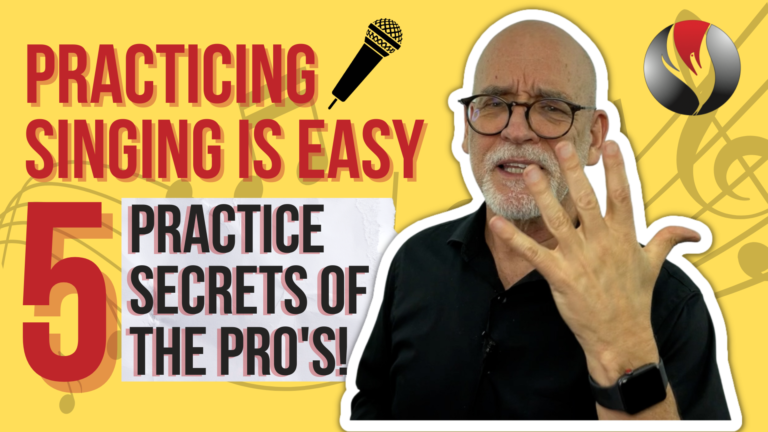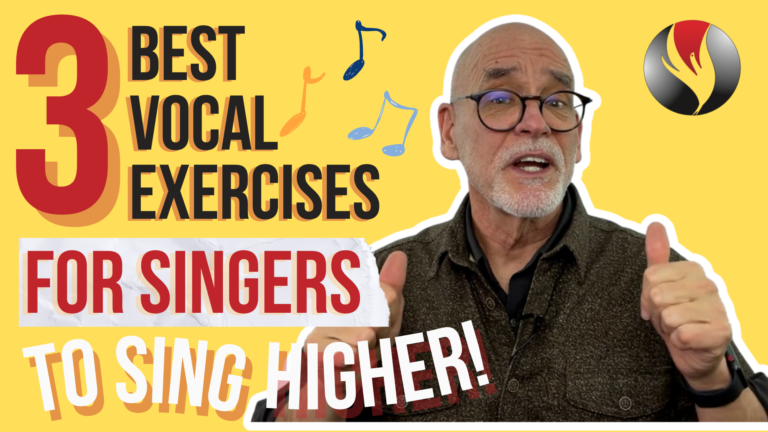Ep.31: How to Sing with Power
Many new students want to know how to sing with more power. They complain their voices are weak and breathy and that they can’t be heard when they sing. They also tell me they’re having a breathing problem because they run out of air very quickly when they sing.
Inside this video I’m going to reveal how to sing with power, eliminate breathiness, increase vocal strength, have plenty of air so no one will ever say, “I couldn’t hear you!”
Hi! I’m Chuck Gilmore with Power To Sing. How to Sing with Power. This is a very common problem many singers and students of singing puzzle and agonize about.
Physically, it all comes down to one thing in your body. Your vocal cords.
If my fingers were my vocal cords, which would make a stronger sound?
This? (Not touching)
This? (Barely Touching)
This? (Firmly Friendly Touching)
This? (Blanching white because touching to hard)
When you sing, the vocal cords must come together enough to resist the air to create a sound wave.
If your vocal cords don’t touch, all the air escapes. You will make no sound. [Demo]
If your cords barely touch, too much air escapes. You sound breathy. [Demo]
Firmly touching..but friendly, adequate for the mood and dynamics of the song, you get a good balance between how firmly the vocal cords are coming together and how how much air is passing through. You can feel the balance… like riding a bicycle without hands. [Demo]
If your cords come together too firmly and unfriendly, too little air escapes and little or no sound is made.
[Demo] Vocal cords closing too firm is the opposite problem of cords not touching enough which is the cause of breathy and weak sounds.
Learn How to Sing With Power Quickly
So how do you learn to close your vocal cords firmly enough to develop the balance between the air and vocal cords?
- If you speak with your vocal cords balanced, friendly and firm, don’t change anything when you start to sing. Think of it as speaking but on a melody. Don’t try and add anything extra to your voice as you start singing.
If I were singing the song “Hey Jude”, I would speak the words first. [Demo] But too many people sing it differently than when the spoke it.
REPEAT: If you speak with your vocal cords balanced, friendly and firm, don’t change anything when you start to sing. Think of it as speaking but on a melody. Don’t try and add anything extra to your voice as you start singing.
2. If you are soft spoken in life, you can’t sing like you speak. Singing is aggressive.
There are many exercises you can do that will bring your cords together more firmly.
Here are a few of them on a 5 tone scale. [Demo]
- [ae] staccato
- [ae] legato
- n [ae]
- g [ae]
- n [ei]
These exercises will bring the cords together more firmly. Take these exercises and apply them in a song. [Demo]
Be careful that you don’t revert back to the way you were doing it. [Demo] When you go back to the words, do them with the same firmness as the exercises.
- If you define yourself as shy or reserved, it can be emotionally difficult to impossible to let yourself firmly bring your cords together. Trick yourself by thinking how firmly you would use your vocal cords if you were saving the life of a child by speaking loudly not to run out into a street with oncoming traffic. Wouldn’t it be like this: “NO! DON’T GO OUT THERE!!!” Rather than: “No, don’t go out there!”?
One of the most exasperating experiences I’ve ever had was spending an entire lesson trying unsuccessfully to get a young pre-teen girl to get her vocal cords together. Only to have her say to a friend in a loud, strong voice as she was leaving, “SHOTGUN”!!!, to get her spot in the front seat of the car!
Next lesson I used that to help her understand what the vocal cords need to do when they sing.
Not necessarily yelling it, but just that strength, that firmness coming together.
If any of this describes your voice, your vocal type is likely Light Chest-No Chest.
Do you know your vocal type? I’m not referring to whether you are a soprano, alto, tenor or bass. Your vocal type is what you tend to do when you sing. In the case of Light Chest-No Chest, your vocal cords are not coming together adequately.
Visit PowerToSing.com and take the vocal test, which I call the PowerTest. Take the quiz and discover your vocal type. Then visit the Knowledge Center and watch the videos and download the exercises designed specifically for your vocal type.
These are designed to help your voice improve quickly.
The exercises for Light Chest-No Chest will help you develop how firmly your vocal cords come together, which will increase the power of your voice.
I’m Chuck Gilmore with Power To Sing. You can sing higher, with beauty, confidence and power.
I’ll see you inside the next video.











Responses